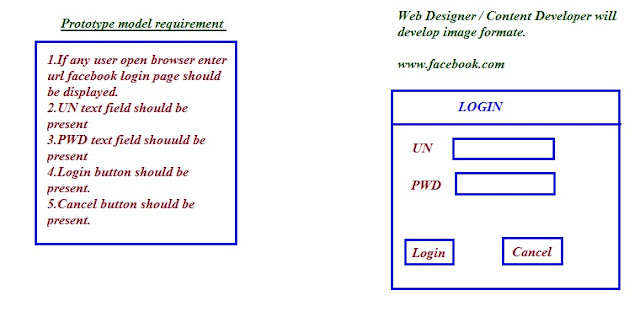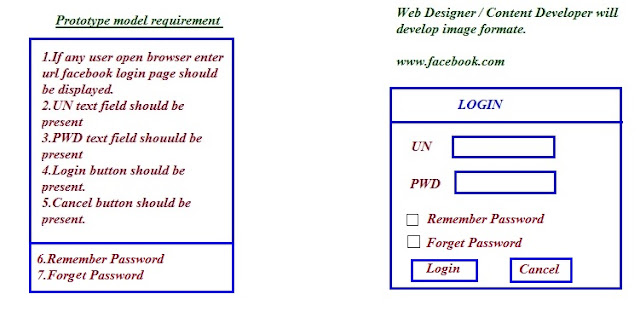Prototype Model
Explanation
- Customer will give (60-70%) requirement.
- Business Analyst will do requirement collection.
- Team will do Feasibility Study.
- Web Designer or Developers will design and develop the prototype and send it to test engineer.
- Test Engineer will do prototype testing. While doing prototype testing if test engineer find any defect (like some of the text might not hove converted to image format).
- Test Engineer will communicate defect to developer.
- Developer will fix the defect in prototype for prototype testing and give it to test engineer.
- Test Engineer will again do prototype testing if there are no defect then they will send prototype for customer review.
- If customer is not satisfied with the prototype then webdesigner will again design the prototype and send it to test engineer.
- Test Engineer will do prototype testing. While doing prototype testing if test engineer find any defect (like some of the text might not hove converted to image format).
- Test Engineer will communicate defect to developer.
- Developer will fix the defect in prototype for prototype testing and give it to test engineer.
- Test Engineer will again do prototype testing if there are no defect then they will send prototype for customer review.
- If customer is satisfy with the prototype customer will approve the prototype.
- Architect will do actual design (i.e. High Level Design and Low Level Design).
- Developer will do actual coding and give the software to test engineer.
- Test Engineer will do actual testing or final testing.
- Once testing is completed quality is good software will be installed or released to customer.
- Later maintenance period will start.
Definition
Prototype model is a dummy model which is prepared by the web designer or content developer or developer where in they convert text format into image format by using HTML, Photoshop and paint etc.
Eg
In the above example we can see how all the text is converted in to image format.
In this way web designer well design the prototype and give it to customer suppose by looking into the image customer got some idea like i want 'Remember Password' and 'Forget Password'.
Then customer will tell this to web designer he will design and give the updated prototype for customer review. Here is the updated model.\
Why we go for prototype model ?
Suppose Business Analyst went to customer place for requirement collection. Since customer was new to business and not aware of complete requirement. Customer gave only 60-70% of requirement assuming company can develop 100% software . Business Analyst assumed around 30% of requirement along with customer given requirement and explain assumed requirement to the developer and test engineer once after development and testing got completed, software was given to the customer. Customer reject the software because software was not matching customer expectation.
In order to overcome this problem in the company will go for prototype model.
What is prototype testing ?
Testing done to check whether customer given all the requirement present in prototype or not.
or
Testing done to check whether text format is converted into image format according to customer requirement.
What is Actual or Final Testing.
Testing the functionality of an application by entering all possible input is called as actual or final Testing.
For which kind of project we go for prototype model ?
- When customer is new to the business.
- When customer is not aware of complete requirement.
- When developer are new to the domain.
Drawbacks
- Total time taken is more.
- Total investment is high.
- There will be delay in releasing software to customer.
Advantages
- Customer will get to know how the software look in the early stage itself.
- There will be good communication between customers and developers so that developer can develop the software according to customer need and necessity.
- We can set high expectation for the customer.
- Requirement changes allowed.
- Very easy to handle requirement changes.




ConversionConversion EmoticonEmoticon